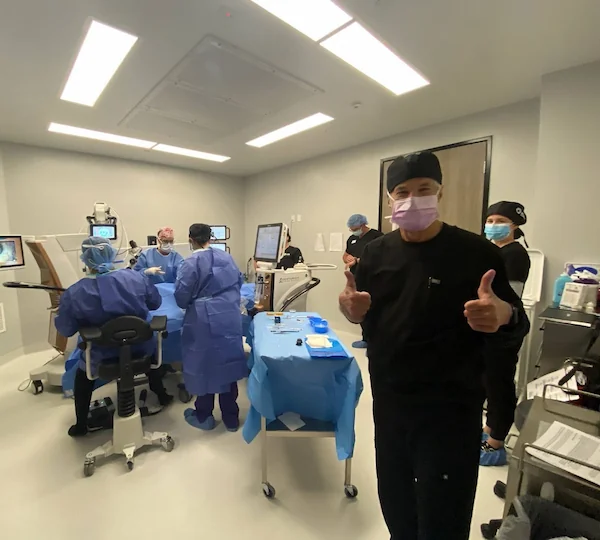Dr. Michael Gordon’s Cataract Surgery Story
Award-winning ophthalmologist and refractive surgeon Dr. Michael Gordon has performed countless vision correction surgery procedures and has also undergone PRK himself. Twenty-five years later, he again found himself a patient when he underwent Cataract Surgery right here at our office-based surgery suite at Gordon Schanzlin New Vision Institute in San Diego. Now, Dr. Gordon shares his unique perspective on cataract surgery: as both a surgeon and a patient.

Dr. Gordon’s Vision Story
Dr. Gordon had PRK vision correction surgery roughly 25 years ago, and still enjoyed nearly perfect vision. However, he knew was in the early stages of cataracts. While his vision was still sharp, he began to face increasing difficulty when driving at night. According to Dr. Gordon, “The oncoming headlights felt like everybody had their brights on.” This became distracting, annoying, and almost painful for him. This is when he knew it was time to have cataract surgery.
What are Cataracts?
Trouble seeing at night, especially when driving, is a common symptom of cataracts. Cataracts are a part of the eye’s natural aging process, and the natural lens of the eye becomes less clear. Cataracts change the way the eye focuses light—it’s something like looking through a dirty window when cataracts progress to a certain point. The cloudy, hazy vision caused by cataracts causes excessive glare when driving at night, and cataracts can also cause light sensitivity.
How Does Cataract Surgery Work?
Once cataracts progress to the point where they are impeding a person’s vision, cataract surgery is necessary. During this procedure, the natural lens of the eye is removed and replaced with an artificial intraocular lens (IOL). At Gordon Schanzlin New Vision Institute, we offer a wide range of IOL options, allowing us to fully customize to meet a patient’s visual needs. In fact, many of our cataract surgery patients say that they enjoy the clearest vision they’ve ever had after the procedure.
What Kind of IOLs Did Dr. Gordon Choose?
Twenty-five years ago, Dr. Gordon underwent PRK with monovision. This means that one of his eyes was corrected for distance vision, and the other was slightly undercorrected for vision to allow for clearer near vision for reading, using his computer or phone, or other close tasks. It was only 6-8 years ago that Dr. Gordon started to need reading glasses, as his eyes underwent another part of the natural aging process called presbyopia.
Dr. Gordon says that he was very happy with his monofocal vision correction after PRK, and that he wanted the same kind of results after his cataract surgery. This is why he chose to have monofocal
IOLs implanted during his procedure.
Dr. Gordon’s Cataract Surgery Experience
Cataract surgery is the most common surgical procedure in the world, and is considered to be very safe and with very rare complications. Still, as a cataract surgeon, Dr. Gordon has intimate knowledge of what can go wrong during the procedure. And, to be honest, it’s normal for any patient to feel some apprehension before surgery.
Not Dr. Gordon. He says, “Even knowing everything I know, I felt incredibly comfortable during my entire experience.”
Dr. Gordon was fortunate to undergo his cataract surgery in our in-office cataract surgery suite, which has been in operation for about one year. Here, patients enjoy a cataract surgery experience that is simple, comfortable, and efficient: most are in and out in roughly an hour. There’s no anesthesiologist, no IV: it’s a very simple, comfortable experience in an office patients are already familiar with (though admittedly not as familiar as Dr. Gordon is!).
Dr. Gordon says that he was so at ease, he considered whether he even needed the oral sedative we offer our patients to help them relax. He felt comfortable at every moment of his experience, and the procedure was over within minutes.
Dr. Gordon’s Recovery After Cataract Surgery
Dr. Gordon tells his patients that cataract surgery is typically brief and easy, but it’s quite another thing to experience that firsthand. All patients undergo cataract surgery on one eye at a time, with the surgeries usually spaced about a week apart because that works best for the patients. Dr. Gordon, however, had one eye corrected on Wednesday, and the next on Thursday.
Following his first cataract surgery, Dr. Gordon says that his vision was a little blurry in the treated eye. By the time his procedure started on Thursday, the vision in the first eye was already clear. By Friday, his vision was fully clear and he was watching TV and engaging in other activities like he always does.
Dr. Gordon went back to work on Monday with 20/20 vision—and he performed surgery on Tuesday!
One thing that was especially notable to Dr. Gordon was how much brighter and truer colors appear after cataract surgery. This is the aspect of vision after cataract surgery that his patients comment on most frequently, and now Dr. Gordon says he, too, appreciates how fantastic it is to see colors as they should be.
Considering Cataract Surgery?
Cataracts happen to nearly everybody, but you don’t need to wait until your vision is significantly impacted to have cataract surgery. Dr. Gordon says, “If you are in your 50s or 60s, are already developing early cataracts and are tired of wearing glasses, don’t wait! Cataract surgery with lens exchange is a safe, simple, and effective procedure that can change your life profoundly.”
If you live in the San Diego area and are ready to learn more about cataract surgery, contact us to schedule a consultation with an experienced ophthalmologist.
The doctors at Gordon Schanzlin New Vision Institute have either authored or reviewed and approved this content.
Page Updated:


